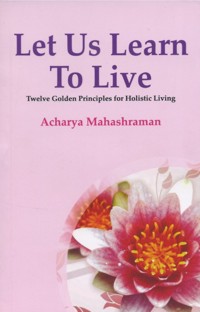If death is a certainty, why should dying not be made an "art" instead of being dreaded? Death is a final "closure" compelling man to part from all he likes, works and aspires for: his assets, friends, family, and even his own body. Santhara is a technique that teaches one to voluntarily, thoughtfully and gladly relinquish all these without regret.
Just as living well is an art, dying with dignity and in peace can also be an art. One who has been trained in the art of living must also learn the art of dying. Bhagavan Mahavira placed as much emphasis on the art of dying as of living. Every living creature has to go through the cycle of life and death. Mahavira pointed out that humans have a unique opportunity to transform this routine into an enlightened process. He preached the importance and benefits of living with restraint and dying in peace. Living and dying any other way would simply waste this unique golden opportunity inherent in human birth.
Death frightens every living being. Although death is understood as an inescapable final event of life, most people are not usually ready to face and accept it. Even when the body becomes frail and the faculties begin failing and death is imminent, the desire to live remains strong. Astrologers are consulted, vows of penance are made and deities are vigorously worshipped. Extraordinary efforts are made to delay, if not shun, death. But the truth is ultimately all life must succumb to this destiny.
Laws of Nature
Nature has set laws to regulate our universe. Just as life is natural, so is death. Life and death are cycles; death after life and life after death. Death spares neither the young nor the old, drawing in everyone without distinction, king and commoner. It does not exempt even the saints. All living beings must succumb to it sometime, whether willingly or unwillingly. Neither intimidation nor prayer can defeat death. The following excerpt from a poem written in Hindi tells the truth about death:
"Swarna-bhasma ko khane vale isee ghatpar aye,
Dane been chabane vale isee ghat par aye.
Gagan-dhvaja faharane vale isee ghat par aye,
Bina kafan marjane vale isee ghat par aye.""All the dead are brought to the same final destination, irrespective of whether they ingested gold or just subsisted on ordinary staples!
No differences remain between the glorious and the destitute. Rich or poor, mighty and feeble, all End up on the same pyre."Since death cannot be controlled, Bhagavan Mahavira said to his principle disciple, "Samayam Goyama! Ma pamayae." "Gautam! Practice vigilance every instant!" Here, vigilance means awareness - awareness of thoughts, actions, emotions, attitudes, and the self. His message was, "Just like a dry tree which can crumble when touched, or a drop of dew on a blade of grass which can be blown away by the slightest breeze, life too is fragile and short. Therefore, be cognizant of every moment."
In this materialistic age people have forgotten spirituality. They equate pleasure with the acquisition of material objects and feel miserable when they do not succeed in their efforts to possess them. This obsession drives them to accumulate far more possessions than they actually need, using any means, fair and foul, to obtain them. They remain engrossed in this pursuit till their last breath, so they have no time to prepare for their end. Because of their foolish pursuits they realize too late that they have missed the opportunity to develop their inner lives.
When asked to do some introspection about their spiritual needs, people commonly tend to sidetrack the issue with the thought, "It is too early to indulge in religious pursuits. There is a long life ahead. This is the time to eat, drink, and be merry. When I retire from work I will look into spirituality." Such thinking is pseudo-intellectual, short-sighted and egotistic and promotes erroneous beliefs against spirituality, self-analysis and humility.
An amusing story illustrates the present-day disinterest in spirituality:
A Sanyasi told a youth, "You should follow some religious practices. Life is precious. Do not spend it only in worldly pleasures and responsibilities."
The youth replied, "Sanyasi Ji! I am quite young. This is when I should earn money. The time to be religious is a long way off, My entire future lies ahead. When I grow old I will follow religion."
During the course of their conversation the Sanyasi asked the youth, "Did you intend to come to see me or were you going somewhere else?" The youth replied, "Well, I was on my way to buy life insurance." The Sanyasi said, "Life insurance? You look quite young. Why do you need it now?" The youth replied, "You are right. I am young. But these days, safety and security cannot be taken for granted and, therefore, one cannot be too confident about life. If a person is insured, his family would be spared the hardships they could face after his death."
The Sanyasi interrupted, 'You are contradicting yourself. Just a while ago you said you would follow the religious path in your old age. Now you say life is uncertain and you may die anytime! You are so unsure about your life that you have decided to buy life insurance, but at the same time you are so confident about living to a ripe old age that you are postponing your religious duties!" The youth immediately realized his mistake.
This is not the story of just this youth, but of all mankind. We postpone spiritual exercises to a tomorrow which never comes but we plan our worldly life for the next moment! How illogical this is! By avoiding spirituality we only perpetuate the cycle of birth and death, and continue to be in bondage to the effects of karma from a succession of past lives.
Jain scriptures mention three types of people with a false perception of death:
This thinking is futile because death can neither be a friend nor can anyone escape it. Nobody has ever succeeded in evading its clutches. The word "Amar", meaning exempt from death, is applied to deities and angels, but according to Jain philosophy even they are not eternal. They too will eventually die and follow the cycle of life and death. If death is a certainty, why should dying not be made an art?
Progressing Towards Self-realization: Sanlekhana
People engrossed in sensory pleasures like taste, touch, sight, sound and smell are constantly on the lookout for ways to fulfill these desires. They crave different foods, fragrances and vistas. They live surrounded by "state of the art" entertainment equipment. And undoubtedly they seek love and affection from a partner, friends and family.
It is natural for people to be delighted when their sensual desires are realized, but such joy is temporary since the next craving may already be sprouting! Such pleasures can not bring true happiness which can only come from the satisfaction of giving up or resisting things for which one typically yearns. Curbing desires also imparts the strength needed to gain control over mind and body. This slow yet steady process can lead to a state where one can recognize the true "self" despite the usual worldly distractions. This could be the best phase of one's life.
By limiting desires, a person enters a relaxing phase before death which should be used as an investment for a brighter future beyond life. In Jain scriptures, this period is called Sanlekhana. This is the time to contemplate the past as well as the present, with the understanding that the imprints of the past can be seen in the present, and that the present will be carried over to the future. This is the time to think over the purpose of life. Life is a lot more than just maintaining relations and carrying out duties and obligations. This could be a definite turning point when no one might be around, yet one can feel the presence of others; when no physical work is carried out, yet one accomplishes by keeping immersed in good thoughts; and even when no great ambitions are to be fulfilled one can stay engrossed in spiritual uplift.
Sanlekhana helps one to become detached physically by limiting food intake and emotionally by letting go of the attachment of relationships. Eventually, Sanlekhana leads one to self-realization which is the right path to a peaceful and dignified death.
State of Self-realization: Santhara
In Jain philosophy Sanlekhana is a prerequisite of Santhara - a unique way of dying. Santhara means voluntarily and consciously giving up everything that sustains life until the end comes without regret. A Hindu Saint Vinobha Bhave, a follower of Mahatma Gandhi, was so impressed by this practice that he resorbed to Jain Santhara for his own death.
One of the three auspicious aspirations prescribed for monks as well as lay people in Jain scriptures is "concentrate on completely detaching the self from physical attachments". The objective is to enter a state of Samadhi (deep meditation) before achieving an "ideal" death.
Santhara must be differentiated from suicide. Santhara is not suicide. Instead, it is self-attainment. Intense passions and emotions are inherent in suicide which is often attributed to severe frustrations and depression. It is an indiscrete and hasty step taken by the desperate who have reached a state of hopelessness and despair. On the contrary Santhara is the final thoughtful act of life, conducted with full awareness, without passion and with no desire to live or die during the process. This is the state of becoming truly immersed within and amounts to a spiritual "celebration".
Why should Santhara be observed? Jain scriptures clearly state that "Santhara should not be observed for worldly fame or with the intent of a better next life. The purpose should not be seeking death but looking for the road that makes death a fulfillment. Santhara is indicated when one wishes to conclude life with supreme peace."
What is the right time for Santhara? Naturally the body should be nourished as long as it is capable of meeting the basic necessities of life and indulging in meaningful spiritual practices. When a person realizes his strength is decreasing, his senses are weakening, and when there is little prospect of recovery from disease or ageing, despite appropriate treatment, Santhara becomes an option. Nevertheless, it should be embraced with courage and only after much deliberation. Sanlekhana is the first and Santhara the final step in the art of dying. Artistic living must incorporate the philosophy of dying. A voluntary end makes one fearless and blissful till the last moment.
 Acharya Mahashraman
Acharya Mahashraman

